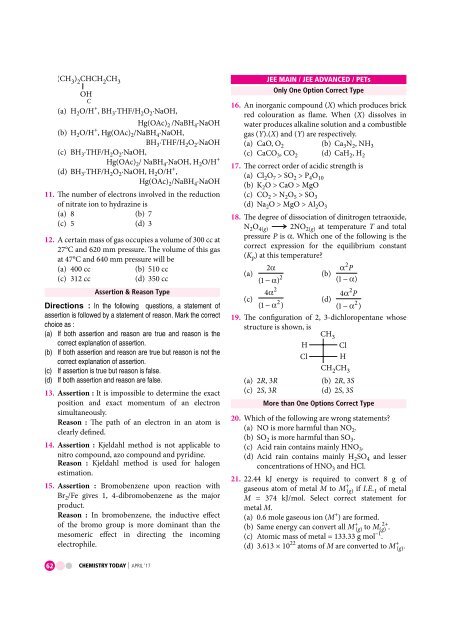Chemistry_Today_April_2017_vk_com_stopthepress
Create successful ePaper yourself
Turn your PDF publications into a flip-book with our unique Google optimized e-Paper software.
(a) H 2 O/H + , BH 3·THF/H 2 O 2·NaOH,<br />
Hg(OAc) 2 /NaBH 4·NaOH<br />
(b) H 2 O/H + , Hg(OAc) 2 /NaBH 4·NaOH,<br />
BH 3·THF/H 2 O 2·NaOH<br />
(c) BH 3·THF/H 2 O 2·NaOH,<br />
Hg(OAc) 2 / NaBH 4·NaOH, H 2 O/H +<br />
(d) BH 3·THF/H 2 O 2·NaOH, H 2 O/H + ,<br />
Hg(OAc) 2 /NaBH 4·NaOH<br />
11. The number of electrons involved in the reduction<br />
of nitrate ion to hydrazine is<br />
(a) 8 (b) 7<br />
(c) 5 (d) 3<br />
12. A certain mass of gas occupies a volume of 300 cc at<br />
27°C and 620 mm pressure. The volume of this gas<br />
at 47°C and 640 mm pressure will be<br />
(a) 400 cc<br />
(b) 510 cc<br />
(c) 312 cc<br />
(d) 350 cc<br />
Assertion & Reason Type<br />
Directions : In the following questions, a statement of<br />
assertion is followed by a statement of reason. Mark the correct<br />
choice as :<br />
(a) If both assertion and reason are true and reason is the<br />
correct explanation of assertion.<br />
(b) If both assertion and reason are true but reason is not the<br />
correct explanation of assertion.<br />
(c) If assertion is true but reason is false.<br />
(d) If both assertion and reason are false.<br />
13. Assertion : It is impossible to determine the exact<br />
position and exact momentum of an electron<br />
simultaneously.<br />
Reason : The path of an electron in an atom is<br />
clearly defined.<br />
14. Assertion : Kjeldahl method is not applicable to<br />
nitro <strong>com</strong>pound, azo <strong>com</strong>pound and pyridine.<br />
Reason : Kjeldahl method is used for halogen<br />
estimation.<br />
15. Assertion : Bromobenzene upon reaction with<br />
Br 2 /Fe gives 1, 4-dibromobenzene as the major<br />
product.<br />
Reason : In bromobenzene, the inductive effect<br />
of the bromo group is more dominant than the<br />
mesomeric effect in directing the in<strong>com</strong>ing<br />
electrophile.<br />
JEE MAIN / JEE ADVANCED / PETs<br />
Only One Option Correct Type<br />
16. An inorganic <strong>com</strong>pound (X) which produces brick<br />
red colouration as flame. When (X) dissolves in<br />
water produces alkaline solution and a <strong>com</strong>bustible<br />
gas (Y).(X) and (Y) are respectively.<br />
(a) CaO, O 2 (b) Ca 3 N 2 , NH 3<br />
(c) CaCO 3 , CO 2 (d) CaH 2 , H 2<br />
17. The correct order of acidic strength is<br />
(a) Cl 2 O 7 > SO 2 > P 4 O 10<br />
(b) K 2 O > CaO > MgO<br />
(c) CO 2 > N 2 O 5 > SO 3<br />
(d) Na 2 O > MgO > Al 2 O 3<br />
18. The degree of dissociation of dinitrogen tetraoxide,<br />
N 2 O 4(g) 2NO 2(g) at temperature T and total<br />
pressure P is α. Which one of the following is the<br />
correct expression for the equilibrium constant<br />
(K p ) at this temperature?<br />
2<br />
2α<br />
α P<br />
(a)<br />
(b)<br />
2<br />
( 1 − α)<br />
( 1 − α)<br />
2<br />
4α<br />
2<br />
4α<br />
P<br />
(c) 2<br />
(d)<br />
( 1 − α )<br />
2<br />
( 1 − α )<br />
19. The configuration of 2, 3-dichloropentane whose<br />
structure is shown, is<br />
(a) 2R, 3R<br />
(c) 2S, 3R<br />
(b) 2R, 3S<br />
(d) 2S, 3S<br />
More than One Options Correct Type<br />
20. Which of the following are wrong statements?<br />
(a) NO is more harmful than NO 2 .<br />
(b) SO 2 is more harmful than SO 3 .<br />
(c) Acid rain contains mainly HNO 3 .<br />
(d) Acid rain contains mainly H 2 SO 4 and lesser<br />
concentrations of HNO 3 and HCl.<br />
21. 22.44 kJ energy is required to convert 8 g of<br />
gaseous atom of metal M to M + (g) if I.E. 1 of metal<br />
M = 374 kJ/mol. Select correct statement for<br />
metal M.<br />
(a) 0.6 mole gaseous ion (M + ) are formed.<br />
(b) Same energy can convert all M + (g) to M 2+ (g) .<br />
(c) Atomic mass of metal = 133.33 g mol –1 .<br />
(d) 3.613 × 10 22 atoms of M are converted to M + (g).<br />
62 CHEMISTRY TODAY | APRIL ‘17


